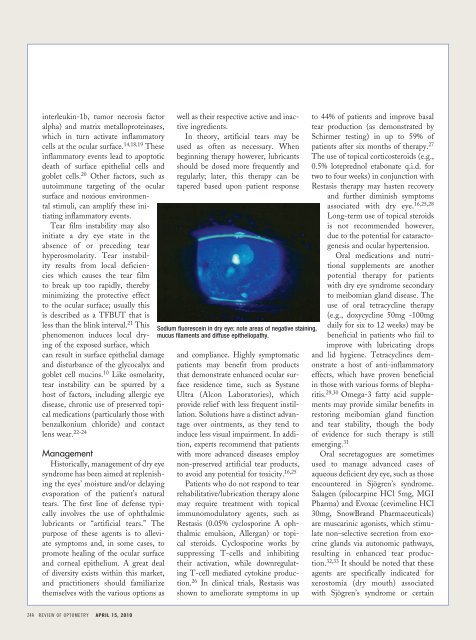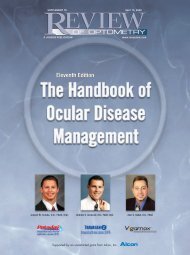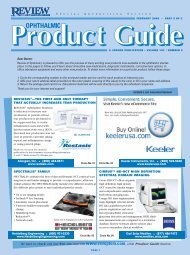Twelfth Edition - Review of Optometry
Twelfth Edition - Review of Optometry
Twelfth Edition - Review of Optometry
You also want an ePaper? Increase the reach of your titles
YUMPU automatically turns print PDFs into web optimized ePapers that Google loves.
interleukin-1b, tumor necrosis factor<br />
alpha) and matrix metalloproteinases,<br />
which in turn activate inflammatory<br />
cells at the ocular surface. 14,18,19 These<br />
inflammatory events lead to apoptotic<br />
death <strong>of</strong> surface epithelial cells and<br />
goblet cells. 20 Other factors, such as<br />
autoimmune targeting <strong>of</strong> the ocular<br />
surface and noxious environmental<br />
stimuli, can amplify these initiating<br />
inflammatory events.<br />
Tear film instability may also<br />
initiate a dry eye state in the<br />
absence <strong>of</strong> or preceding tear<br />
hyperosmolarity. Tear instability<br />
results from local deficiencies<br />
which causes the tear film<br />
to break up too rapidly, thereby<br />
minimizing the protective effect<br />
to the ocular surface; usually this<br />
is described as a TFBUT that is<br />
less than the blink interval. 21 This<br />
phenomenon induces local drying<br />
<strong>of</strong> the exposed surface, which<br />
can result in surface epithelial damage<br />
and disturbance <strong>of</strong> the glycocalyx and<br />
goblet cell mucins. 10 Like osmolarity,<br />
tear instability can be spurred by a<br />
host <strong>of</strong> factors, including allergic eye<br />
disease, chronic use <strong>of</strong> preserved topical<br />
medications (particularly those with<br />
benzalkonium chloride) and contact<br />
lens wear. 22-24<br />
Management<br />
Historically, management <strong>of</strong> dry eye<br />
syndrome has been aimed at replenishing<br />
the eyes’ moisture and/or delaying<br />
evaporation <strong>of</strong> the patient’s natural<br />
tears. The first line <strong>of</strong> defense typically<br />
involves the use <strong>of</strong> ophthalmic<br />
lubricants or “artificial tears.” The<br />
purpose <strong>of</strong> these agents is to alleviate<br />
symptoms and, in some cases, to<br />
promote healing <strong>of</strong> the ocular surface<br />
and corneal epithelium. A great deal<br />
<strong>of</strong> diversity exists within this market,<br />
and practitioners should familiarize<br />
themselves with the various options as<br />
24A REVIEW OF OPTOMETRY APRIL 15, 2010<br />
well as their respective active and inactive<br />
ingredients.<br />
In theory, artificial tears may be<br />
used as <strong>of</strong>ten as necessary. When<br />
beginning therapy however, lubricants<br />
should be dosed more frequently and<br />
regularly; later, this therapy can be<br />
tapered based upon patient response<br />
Sodium fluorescein in dry eye: note areas <strong>of</strong> negative staining,<br />
mucus filaments and diffuse epitheliopathy.<br />
and compliance. Highly symptomatic<br />
patients may benefit from products<br />
that demonstrate enhanced ocular surface<br />
residence time, such as Systane<br />
Ultra (Alcon Laboratories), which<br />
provide relief with less frequent instillation.<br />
Solutions have a distinct advantage<br />
over ointments, as they tend to<br />
induce less visual impairment. In addition,<br />
experts recommend that patients<br />
with more advanced diseases employ<br />
non-preserved artificial tear products,<br />
to avoid any potential for toxicity. 16,25<br />
Patients who do not respond to tear<br />
rehabilitative/lubrication therapy alone<br />
may require treatment with topical<br />
immunomodulatory agents, such as<br />
Restasis (0.05% cyclosporine A ophthalmic<br />
emulsion, Allergan) or topical<br />
steroids. Cyclosporine works by<br />
suppressing T-cells and inhibiting<br />
their activation, while downregulating<br />
T-cell mediated cytokine production.<br />
26 In clinical trials, Restasis was<br />
shown to ameliorate symptoms in up<br />
to 44% <strong>of</strong> patients and improve basal<br />
tear production (as demonstrated by<br />
Schirmer testing) in up to 59% <strong>of</strong><br />
patients after six months <strong>of</strong> therapy. 27<br />
The use <strong>of</strong> topical corticosteroids (e.g.,<br />
0.5% loteprednol etabonate q.i.d. for<br />
two to four weeks) in conjunction with<br />
Restasis therapy may hasten recovery<br />
and further diminish symptoms<br />
associated with dry eye. 16,25,28<br />
Long-term use <strong>of</strong> topical steroids<br />
is not recommended however,<br />
due to the potential for cataractogenesis<br />
and ocular hypertension.<br />
Oral medications and nutritional<br />
supplements are another<br />
potential therapy for patients<br />
with dry eye syndrome secondary<br />
to meibomian gland disease. The<br />
use <strong>of</strong> oral tetracycline therapy<br />
(e.g., doxycycline 50mg -100mg<br />
daily for six to 12 weeks) may be<br />
beneficial in patients who fail to<br />
improve with lubricating drops<br />
and lid hygiene. Tetracyclines demonstrate<br />
a host <strong>of</strong> anti-inflammatory<br />
effects, which have proven beneficial<br />
in those with various forms <strong>of</strong> blepharitis.<br />
29,30 Omega-3 fatty acid supplements<br />
may provide similar benefits in<br />
restoring meibomian gland function<br />
and tear stability, though the body<br />
<strong>of</strong> evidence for such therapy is still<br />
emerging. 31<br />
Oral secretagogues are sometimes<br />
used to manage advanced cases <strong>of</strong><br />
aqueous deficient dry eye, such as those<br />
encountered in Sjögren’s syndrome.<br />
Salagen (pilocarpine HCl 5mg, MGI<br />
Pharma) and Evoxac (cevimeline HCl<br />
30mg, SnowBrand Pharmaceuticals)<br />
are muscarinic agonists, which stimulate<br />
non-selective secretion from exocrine<br />
glands via autonomic pathways,<br />
resulting in enhanced tear production.<br />
32,33 It should be noted that these<br />
agents are specifically indicated for<br />
xerostomia (dry mouth) associated<br />
with Sjögren’s syndrome or certain





